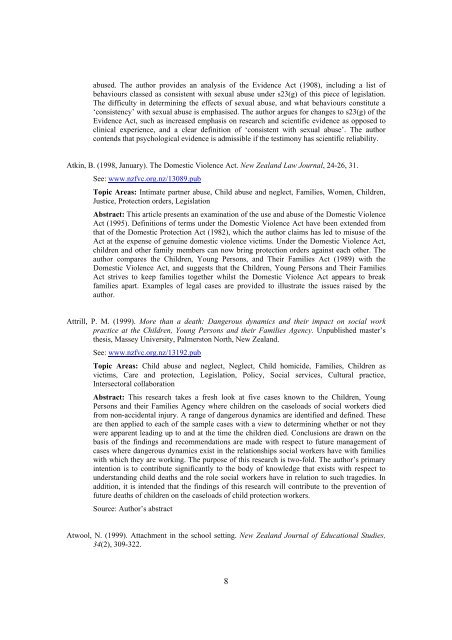annotated bibliography of new zealand research into family violence
annotated bibliography of new zealand research into family violence
annotated bibliography of new zealand research into family violence
You also want an ePaper? Increase the reach of your titles
YUMPU automatically turns print PDFs into web optimized ePapers that Google loves.
abused. The author provides an analysis <strong>of</strong> the Evidence Act (1908), including a list <strong>of</strong>behaviours classed as consistent with sexual abuse under s23(g) <strong>of</strong> this piece <strong>of</strong> legislation.The difficulty in determining the effects <strong>of</strong> sexual abuse, and what behaviours constitute a‘consistency’ with sexual abuse is emphasised. The author argues for changes to s23(g) <strong>of</strong> theEvidence Act, such as increased emphasis on <strong>research</strong> and scientific evidence as opposed toclinical experience, and a clear definition <strong>of</strong> ‘consistent with sexual abuse’. The authorcontends that psychological evidence is admissible if the testimony has scientific reliability.Atkin, B. (1998, January). The Domestic Violence Act. New Zealand Law Journal, 24-26, 31.See: www.nzfvc.org.nz/13089.pubTopic Areas: Intimate partner abuse, Child abuse and neglect, Families, Women, Children,Justice, Protection orders, LegislationAbstract: This article presents an examination <strong>of</strong> the use and abuse <strong>of</strong> the Domestic ViolenceAct (1995). Definitions <strong>of</strong> terms under the Domestic Violence Act have been extended fromthat <strong>of</strong> the Domestic Protection Act (1982), which the author claims has led to misuse <strong>of</strong> theAct at the expense <strong>of</strong> genuine domestic <strong>violence</strong> victims. Under the Domestic Violence Act,children and other <strong>family</strong> members can now bring protection orders against each other. Theauthor compares the Children, Young Persons, and Their Families Act (1989) with theDomestic Violence Act, and suggests that the Children, Young Persons and Their FamiliesAct strives to keep families together whilst the Domestic Violence Act appears to breakfamilies apart. Examples <strong>of</strong> legal cases are provided to illustrate the issues raised by theauthor.Attrill, P. M. (1999). More than a death: Dangerous dynamics and their impact on social workpractice at the Children, Young Persons and their Families Agency. Unpublished master’sthesis, Massey University, Palmerston North, New Zealand.See: www.nzfvc.org.nz/13192.pubTopic Areas: Child abuse and neglect, Neglect, Child homicide, Families, Children asvictims, Care and protection, Legislation, Policy, Social services, Cultural practice,Intersectoral collaborationAbstract: This <strong>research</strong> takes a fresh look at five cases known to the Children, YoungPersons and their Families Agency where children on the caseloads <strong>of</strong> social workers diedfrom non-accidental injury. A range <strong>of</strong> dangerous dynamics are identified and defined. Theseare then applied to each <strong>of</strong> the sample cases with a view to determining whether or not theywere apparent leading up to and at the time the children died. Conclusions are drawn on thebasis <strong>of</strong> the findings and recommendations are made with respect to future management <strong>of</strong>cases where dangerous dynamics exist in the relationships social workers have with familieswith which they are working. The purpose <strong>of</strong> this <strong>research</strong> is two-fold. The author’s primaryintention is to contribute significantly to the body <strong>of</strong> knowledge that exists with respect tounderstanding child deaths and the role social workers have in relation to such tragedies. Inaddition, it is intended that the findings <strong>of</strong> this <strong>research</strong> will contribute to the prevention <strong>of</strong>future deaths <strong>of</strong> children on the caseloads <strong>of</strong> child protection workers.Source: Author’s abstractAtwool, N. (1999). Attachment in the school setting. New Zealand Journal <strong>of</strong> Educational Studies,34(2), 309-322.8












